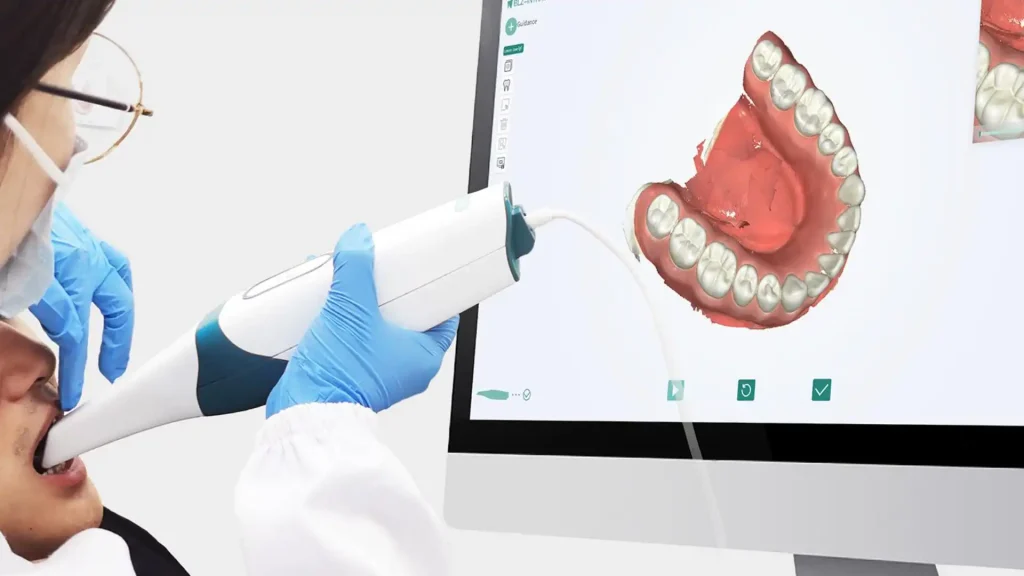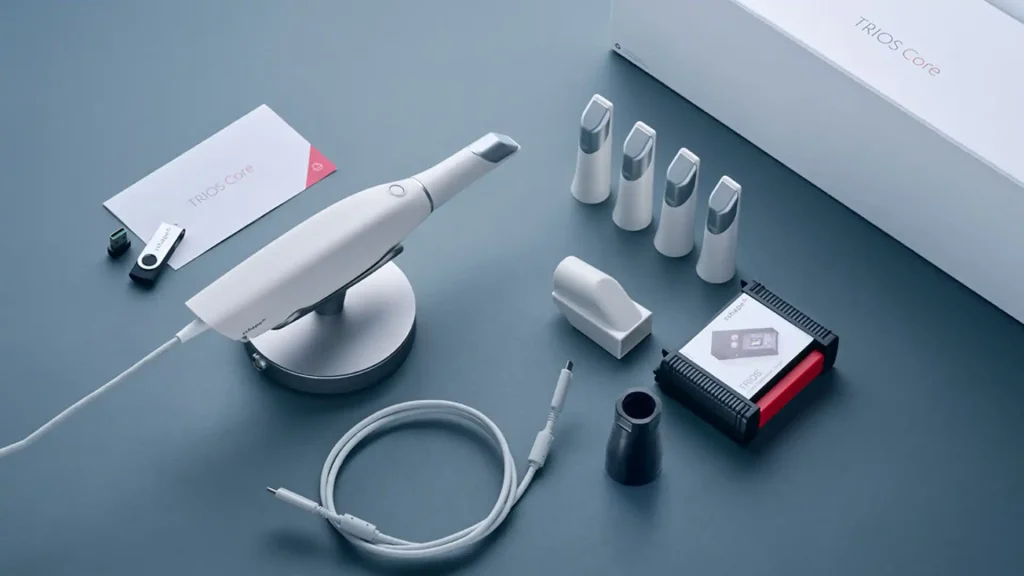
Intraoral Scanners Vs Traditional Impressions
For many, the experience of getting dental impressions is all too familiar. Traditional impression methods, using materials like alginate or silicone, often come with a host of unpleasant issues: poor taste and odor, gagging, a lengthy process, and the potential for inaccuracies. But today, the intraoral scanner has emerged as a revolutionary technology, offering an efficient and comfortable alternative. This article provides a comprehensive overview of the advantages of intraoral scanners compared to traditional impression methods. We’ll show how this technology creates a vastly improved experience for both patients and dental professionals.

Traditional Dental Impressions: A Challenging Approach
Traditional dental impressions involve creating a physical replica of the teeth and surrounding soft tissues. Dentists typically use materials like alginate or silicones to create these replicas. The steps of traditional impressions include selecting the tray, mixing the materials, loading the tray, placing the tray in the patient’s mouth, and waiting for the material to set.
Despite their widespread use, traditional impressions have several drawbacks:
- Patient Discomfort: The unpleasant taste and smell of the materials, the feeling of a full mouth, and gagging (especially in individuals with a strong gag reflex) are common complaints.
- Time-Consuming: mixing materials, placing them in the mouth, and waiting for them to set takes considerable time.
- Potential for errors: air bubbles, material distortion because of patient movement, tearing of the impression, and failure to capture fine details can all cause retaking the impression.
- Limitations for Certain Individuals: Traditional impressions can be difficult for children, individuals with certain disabilities, and those who cannot keep their mouths open for extended periods.
- Hygiene Considerations: Risk of cross contamination.
Intraoral Scanners: When Technology Serving Dentistry
An intraoral scanner is an advanced device that uses optical or laser technology to create a three-dimensional, digital image of the teeth and soft tissues of the mouth. These scanners resemble a small camera that is moved inside the mouth, transmitting data to a computer. Specialized software processes this information to create a precise 3D model of the patient’s mouth.
The advantages of intraoral scanners are truly impressive:
- Unparalleled Patient Comfort: The scan is quick and easy because it requires no bulky, bad-tasting impression materials, and patients do not gag or feel suffocated.
- Exceptional Accuracy: Intraoral scanners produce highly accurate 3D models, minimizing human error. This high level of precision is crucial in complex treatments like implants and orthodontics.
- High Speed: Digital scanning is much faster than traditional impressions, reducing the patient’s chair time.
- Hygiene: Eliminating the use of impression materials significantly reduces the risk of cross-contamination. Scanner tips are sterilizable.
- Reduced Waste: Eliminating the need for impression materials reduces waste, contributing to environmental sustainability.
- Immediate Results: The dentist and patient can view the 3D model immediately after scanning, allowing for any necessary adjustments to be made in the same appointment.
- Efficient Lab Communication: The digital scan file can be easily and quickly sent to the dental laboratory, streamlining the prosthesis fabrication process.
- Wide Range of Applications: Intraoral scanners are used in a wide variety of dental treatments, including implants, orthodontics, crowns, bridges, veneers, and smile design.
A Comparison: Intraoral Scanners vs. Traditional Impressions
| Feature | Intraoral Scanner | Traditional Impression |
|---|---|---|
| Patient Comfort | Very comfortable, no taste/odor, no gagging | Uncomfortable, unpleasant taste/odor, gagging risk |
| Accuracy | Very high, precise 3D model | Potential for errors, depends on dentist’s skill |
| Speed | Quick | Time-consuming |
| Hygiene | Completely hygienic, reduced infection risk | Potential for cross-contamination |
| Cost (Patient) | May be slightly higher (but cost-effective long-term) | Usually lower |
| Cost (Dentist) | Requires initial investment in equipment | Lower cost for materials and equipment |
| Applications | Very broad | More limited |
As the table clearly shows, the intraoral scanner offers significant advantages over traditional methods most times. While the initial cost for the dentist may be higher, the long-term benefits, including increased patient satisfaction, reduced errors, and time savings, justify the investment.
Types of Intraoral Scanners
Intraoral scanners are categorized based on their imaging technology:
- Structured Light Scanners: These scanners use a specific light pattern (usually lines or dots) to create a 3D image. A projector casts the pattern onto the teeth, and one or more cameras record the distortion of the pattern. Software analyzes these changes to construct the 3D model.
- Laser Scanners: These scanners use a laser beam to scan the teeth. The scanner projects the laser onto the tooth surface, and a sensor measures the reflection time. Based on this time, the system calculates the distance and depth of various points, creating a 3D image.
- Confocal Scanners: This advanced technology uses multiple cameras to capture images from different angles. The system then combines these images to create a highly detailed 3D model.
- Video Scanners: These scanners essentially capture 3D videos of the teeth.
Each of these technologies has its own advantages and disadvantages. For example, laser scanners may offer higher accuracy, while structured light scanners are generally faster.
Applications of Intraoral Scanners in Dentistry
As mentioned earlier, intraoral scanners have a wide range of applications. Here are some of the most important ones:
- Dentists use digital scans to determine implant placement precisely, design abutments precisely, and fabricate the final restoration precisely. This high accuracy contributes to the success of implant treatment.
- Orthodontics: Intraoral scanners have replaced traditional impressions for creating clear aligners (like Invisalign) and other orthodontic appliances. This provides greater comfort for orthodontic patients.
- Dental Prostheses (Crowns, Bridges, Veneers): Digital scans provide accurate information for fabricating dental prostheses, allowing the lab to create restorations with excellent fit and natural aesthetics.
- Digital Smile Design: Using intraoral scanners and smile design software, the final result can be shown to the patient before treatment begins, allowing for more precise treatment planning.
- Detection of Caries and Gum Disease: Some advanced scanners can also detect early caries and analyze gum health.
- Surgical Guides: Digital scans can create surgical guides, which increase the accuracy of implant and other oral surgeries.
- Treatment Monitoring and Follow-up: Periodic scans track changes in teeth and gums over time, and we can evaluate treatment effectiveness.
Training and Learning to Use Intraoral Scanners
Using an intraoral scanner requires training and skill. Dentists and their assistants must learn to operate the device properly, scan teeth, process data, and send files to the lab. Scanner manufacturers typically offer training courses for users. Online educational resources and video tutorials can also be helpful.
The Future of Intraoral Scanners
Intraoral scanner technology is rapidly advancing. We can expect to see the following in the future:
- Smaller and Lighter Scanners: Scanners with a more ergonomic design for easier use.
- Faster Scanners: Further reduction in scanning time and increased efficiency.
- Wireless Scanners: Elimination of wires and increased freedom of movement for the dentist.
- Integration with Artificial Intelligence (AI): Use of AI for automated scan analysis, disease detection, and treatment suggestions.
- Reduced Cost: Increased competition and technological advancements will decrease scanner prices, making them accessible to more dental professionals.
- Multifunctional Scanners: Combining scanning capabilities with other diagnostic tools, such as intraoral cameras and radiography.
Final Thoughts:
The intraoral scanner is more than just a simple tool for creating digital models of teeth. This technology represents a fundamental shift in dentistry, bringing countless benefits to both patients and dentists. High accuracy, patient comfort, speed, hygiene, a wide range of applications, and efficient lab communication are just some of these advantages. Given the rapid advancements in this field, the intraoral scanner will undoubtedly play an increasingly important role in the future of dentistry, significantly improving the quality of oral healthcare. Investing in this technology is a wise investment for dentists who are committed to providing the best possible care to their patients.
